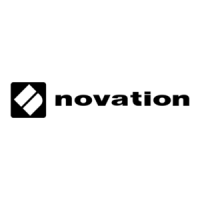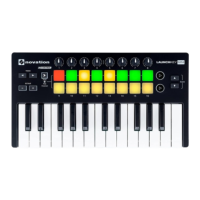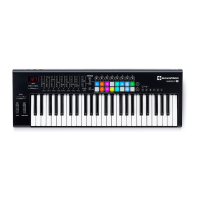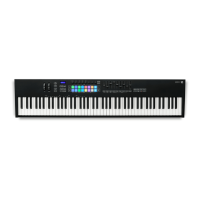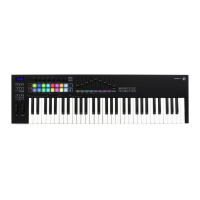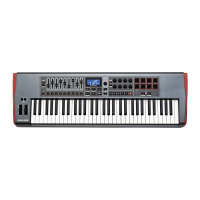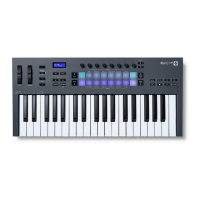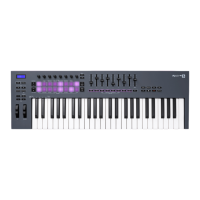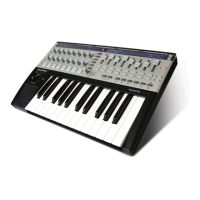Do you have a question about the Novation Launchkey Series and is the answer not in the manual?
Lists core functionalities and benefits of the Launchkey controller for music production.
Details the items included in the Launchkey product packaging for new users.
Guides users through the initial setup and registration process for the Launchkey.
Provides information on where to find additional help and support resources.
Outlines the differences and specific features across Launchkey models.
Illustrates and describes the physical components and layout of the Launchkey hardware.
Explains how to connect the Launchkey to a computer and other MIDI devices.
Instructions for installing Ableton Live and the Launchkey integration software.
Details the configuration steps for using Launchkey with Ableton Live.
Overview of Session Mode for controlling Ableton Live's Session View.
Explains how to launch clips using the Launchkey pads in Session Mode.
Describes how to launch entire scenes in Ableton Live using the Launchkey.
Details how to use pads for stopping, soloing, or muting tracks in Session Mode.
Explains triggering Session Record for recording new or overdubbing existing clips.
Describes using Capture MIDI to retrospectively record MIDI notes.
Explains how to quantise MIDI notes to the grid for timing accuracy.
Details how to toggle Ableton's metronome on and off.
Describes triggering the undo function within Ableton Live.
Explains the Arm/Select button functionality for tracks on specific models.
Details how to use the Launchkey pads as velocity-sensitive drum pads.
Overview of controlling Ableton Live's mixer with Launchkey's pots and faders.
Explains how pots control mixer parameters like volume, pan, and sends.
Describes how faders control mixer parameters like volume and sends.
Details how to navigate and control Ableton devices using Launchkey.
Explains how to select devices on a track using the Device Select button.
Describes how to lock device controls to the current track or selected device.
Details how the MIDI buttons function as transport controls in Ableton Live.
Describes the 2x8 grid of velocity-sensitive pads for standalone operation.
Explains how to use the pads in Drum Mode for outputting MIDI notes.
Introduces modes for playing chords, including Scale Chord and User Chord.
Details using predefined chord banks and navigating through scale-based chords.
Guides on creating and saving custom chords assigned to pads.
Explains how to create and transpose a fixed chord shape.
Allows the keyboard to play only notes within a selected musical scale.
Describes configuring knobs, pads, and faders for custom MIDI messages.
Details custom modes for pads, including MIDI notes and CC messages.
Explains custom modes for pots, allowing configuration of custom CC numbers.
Covers custom modes for faders, enabling custom CC number allocation.
Introduces the arpeggiator feature for creating melodies from chords.
Explains how rotary pots control arpeggio parameters like tempo, swing, and gate.
Details the 7 different arpeggiator modes for varying note orders.
Describes how to set the speed of arpeggiated notes using common musical values.
Explains how to set the number of octaves the arpeggio repeats across.
Details how to add musical rests to arpeggios for greater variation.
Enables using the arpeggiator without holding keys, latching patterns.
Allows direct access to arp controls without holding Shift.
Describes how octave buttons adjust the keyboard octave and transposition.
Details various device settings like MIDI channels, velocity curves, and brightness.
Explains the Pot Pickup feature to prevent sudden control value jumps.
Describes using the '...' button for navigation mode to browse samples and presets.
Setup and integration guide for using Launchkey with Apple Logic Pro X.
Instructions for installing drivers and scripts for Logic Pro X.
How to use Session Mode for controlling Logic Pro tracks (record, mute, solo).
Details how pots control device parameters, volume, pan, and sends in Logic.
Explains fader control for device parameters, volume, and sends in Logic.
Functionality of Arm/Select button for track arming and selection in Logic.
How MIDI buttons function as transport controls in Logic Pro.
Using navigation buttons to switch between tracks in Logic.
Setup and integration guide for using Launchkey with Propellerhead Reason.
Instructions for installing the script for Reason integration.
How transport buttons function within Reason.
How rotary knobs control instrument parameters in Reason.
Using pads in Session Mode to control device settings in Reason.
Using navigation buttons to switch between tracks in Reason.
Scrolling through presets on Reason instruments.
Using Launchkey as a HUI controller for DAWs like Pro Tools, Cubase, Studio One.
Describes HUI setup procedures for Pro Tools, Cubase, and Studio One.
Using pads in Session Mode for muting and soloing tracks in HUI DAWs.
Using navigation buttons to move between tracks in HUI DAWs.
Controlling mixer parameters like volume, pan, and sends via HUI.
Fader and button functionality for track volumes and arming/selection in HUI.
Transport button functions when used with HUI.
Creating and sending unique MIDI templates using Novation Components software.
Lists core functionalities and benefits of the Launchkey controller for music production.
Details the items included in the Launchkey product packaging for new users.
Guides users through the initial setup and registration process for the Launchkey.
Provides information on where to find additional help and support resources.
Outlines the differences and specific features across Launchkey models.
Illustrates and describes the physical components and layout of the Launchkey hardware.
Explains how to connect the Launchkey to a computer and other MIDI devices.
Instructions for installing Ableton Live and the Launchkey integration software.
Details the configuration steps for using Launchkey with Ableton Live.
Overview of Session Mode for controlling Ableton Live's Session View.
Explains how to launch clips using the Launchkey pads in Session Mode.
Describes how to launch entire scenes in Ableton Live using the Launchkey.
Details how to use pads for stopping, soloing, or muting tracks in Session Mode.
Explains triggering Session Record for recording new or overdubbing existing clips.
Describes using Capture MIDI to retrospectively record MIDI notes.
Explains how to quantise MIDI notes to the grid for timing accuracy.
Details how to toggle Ableton's metronome on and off.
Describes triggering the undo function within Ableton Live.
Explains the Arm/Select button functionality for tracks on specific models.
Details how to use the Launchkey pads as velocity-sensitive drum pads.
Overview of controlling Ableton Live's mixer with Launchkey's pots and faders.
Explains how pots control mixer parameters like volume, pan, and sends.
Describes how faders control mixer parameters like volume and sends.
Details how to navigate and control Ableton devices using Launchkey.
Explains how to select devices on a track using the Device Select button.
Describes how to lock device controls to the current track or selected device.
Details how the MIDI buttons function as transport controls in Ableton Live.
Describes the 2x8 grid of velocity-sensitive pads for standalone operation.
Explains how to use the pads in Drum Mode for outputting MIDI notes.
Introduces modes for playing chords, including Scale Chord and User Chord.
Details using predefined chord banks and navigating through scale-based chords.
Guides on creating and saving custom chords assigned to pads.
Explains how to create and transpose a fixed chord shape.
Allows the keyboard to play only notes within a selected musical scale.
Describes configuring knobs, pads, and faders for custom MIDI messages.
Details custom modes for pads, including MIDI notes and CC messages.
Explains custom modes for pots, allowing configuration of custom CC numbers.
Covers custom modes for faders, enabling custom CC number allocation.
Introduces the arpeggiator feature for creating melodies from chords.
Explains how rotary pots control arpeggio parameters like tempo, swing, and gate.
Details the 7 different arpeggiator modes for varying note orders.
Describes how to set the speed of arpeggiated notes using common musical values.
Explains how to set the number of octaves the arpeggio repeats across.
Details how to add musical rests to arpeggios for greater variation.
Enables using the arpeggiator without holding keys, latching patterns.
Allows direct access to arp controls without holding Shift.
Describes how octave buttons adjust the keyboard octave and transposition.
Details various device settings like MIDI channels, velocity curves, and brightness.
Explains the Pot Pickup feature to prevent sudden control value jumps.
Describes using the '...' button for navigation mode to browse samples and presets.
Setup and integration guide for using Launchkey with Apple Logic Pro X.
Instructions for installing drivers and scripts for Logic Pro X.
How to use Session Mode for controlling Logic Pro tracks (record, mute, solo).
Details how pots control device parameters, volume, pan, and sends in Logic.
Explains fader control for device parameters, volume, and sends in Logic.
Functionality of Arm/Select button for track arming and selection in Logic.
How MIDI buttons function as transport controls in Logic Pro.
Using navigation buttons to switch between tracks in Logic.
Setup and integration guide for using Launchkey with Propellerhead Reason.
Instructions for installing the script for Reason integration.
How transport buttons function within Reason.
How rotary knobs control instrument parameters in Reason.
Using pads in Session Mode to control device settings in Reason.
Using navigation buttons to switch between tracks in Reason.
Scrolling through presets on Reason instruments.
Using Launchkey as a HUI controller for DAWs like Pro Tools, Cubase, Studio One.
Describes HUI setup procedures for Pro Tools, Cubase, and Studio One.
Using pads in Session Mode for muting and soloing tracks in HUI DAWs.
Using navigation buttons to move between tracks in HUI DAWs.
Controlling mixer parameters like volume, pan, and sends via HUI.
Fader and button functionality for track volumes and arming/selection in HUI.
Transport button functions when used with HUI.
Creating and sending unique MIDI templates using Novation Components software.
| Velocity Sensitive | Yes |
|---|---|
| Transport Controls | Yes |
| Pitch Bend/Mod Wheel | Yes |
| Arpeggiator | Yes |
| Scale Mode | Yes |
| Dimensions | Varies by model |
| Weight | Varies by model |
| Type | MIDI Controller Keyboard |
| Key Count | 25, 37, 49, 61 |
| Pads | 16 RGB Backlit Velocity Sensitive Pads |
| Knobs | 8 |
| Faders | 9 |
| Connectivity | USB |
| Software Included | Ableton Live Lite, XLN Audio Addictive Keys |
| Capture MIDI | Yes |
| DAW Integration | Ableton Live, Logic Pro, Cubase |
| Power Source | USB |
| Aftertouch | Channel Aftertouch (on some models) |

